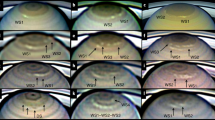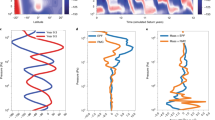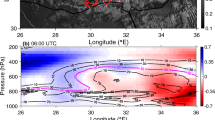Abstract
Convective storms occur regularly in Saturn’s atmosphere1,2,3,4. Huge storms known as Great White Spots, which are ten times larger than the regular storms, are rarer and occur about once per Saturnian year (29.5 Earth years). Current models propose that the outbreak of a Great White Spot is due to moist convection induced by water5,6. However, the generation of the global disturbance and its effect on Saturn’s permanent winds1,7 have hitherto been unconstrained8 by data, because there was insufficient spatial resolution and temporal sampling9,10,11 to infer the dynamics of Saturn’s weather layer (the layer in the troposphere where the cloud forms). Theoretically, it has been suggested that this phenomenon is seasonally controlled5,9,10. Here we report observations of a storm at northern latitudes in the peak of a weak westward jet during the beginning of northern springtime, in accord with the seasonal cycle but earlier than expected. The storm head moved faster than the jet, was active during the two-month observation period, and triggered a planetary-scale disturbance that circled Saturn but did not significantly alter the ambient zonal winds. Numerical simulations of the phenomenon show that, as on Jupiter12, Saturn’s winds extend without decay deep down into the weather layer, at least to the water-cloud base at pressures of 10–12 bar, which is much deeper than solar radiation penetrates.
This is a preview of subscription content, access via your institution
Access options
Subscribe to this journal
Receive 51 print issues and online access
$199.00 per year
only $3.90 per issue
Buy this article
- Purchase on Springer Link
- Instant access to full article PDF
Prices may be subject to local taxes which are calculated during checkout




Similar content being viewed by others
References
Del Genio, A. D. et al. in Saturn from Cassini-Huygens (eds Dougherty, M., Esposito, L. & Krimigis, T. ) 113–159 (Springer, 2009)
Porco, C. C. et al. Cassini imaging science: initial results on Saturn’s atmosphere. Science 307, 1243–1247 (2005)
Dyudina, U. A. et al. Lightning storms on Saturn observed by Cassini ISS and RPWS during 2004–2006. Icarus 190, 545–555 (2007)
Fischer, G. et al. Analysis of a giant lightning storm on Saturn. Icarus 190, 528–544 (2007)
Sánchez-Lavega, A. & Battaner, E. The nature of Saturn’s atmospheric Great White Spots. Astron. Astrophys. 185, 315–326 (1987)
Hueso, R. & Sánchez-Lavega, A. A. Three-dimensional model of moist convection for the giant planets II: Saturn's water and ammonia moist convective storms. Icarus 172, 255–271 (2004)
Sánchez-Lavega, A., Rojas, J. F. & Sada, P. V. Saturn’s zonal winds at cloud level. Icarus 147, 405–420 (2000)
Sayanagi, K. M. & Showman, A. P. Effects of a large convective storm on Saturn’s equatorial jet. Icarus 187, 520–539 (2007)
Sánchez-Lavega, A. et al. The Great White Spot and disturbances in Saturn’s equatorial atmosphere during 1990. Nature 353, 397–401 (1991)
Sánchez-Lavega, A., Lecacheux, J., Colas, F. & Laques, P. Temporal behavior of cloud morphologies and motions in Saturn’s atmosphere. J. Geophys. Res. 98 (E10). 18857–18872 (1993)
Barnet, C. D., Westphal, J. A., Beebe, R. F. & Huber, L. F. Hubble Space Telescope observations of the 1990 equatorial disturbance on Saturn: zonal winds and central meridian albedos. Icarus 100, 499–511 (1992)
Sánchez-Lavega, A. et al. Depth of a strong jovian jet from a planetary-scale disturbance driven by storms. Nature 451, 437–440 (2008)
Fischer, G. et al. A giant thunderstorm on Saturn. Nature 10.1038/nature10205 (this issue).
Sánchez-Lavega, A. Motions in Saturn’s atmosphere: observations before Voyager encounters. Icarus 49, 1–16 (1982)
Beebe, R. F., Barnet, C., Sada, P. V. & Murrell, A. S. The onset and growth of the 1990 equatorial disturbance on Saturn. Icarus 95, 163–172 (1992)
Seidelmann, P. K. et al. Report of the IAU/IAG working group on cartographic coordinates and rotational elements: 2006. Celestial Mech. Dyn. Astron. 98, 155–180 (2007)
Sánchez Lavega, A. et al. Large-scale storms in Saturn’s atmosphere during 1994. Science 271, 631–634 (1996)
Acarreta, J. R. & Sánchez-Lavega, A. Vertical cloud structure in Saturn’s 1990 equatorial storm. Icarus 137, 24–33 (1999)
Pérez-Hoyos, S., Sánchez-Lavega, A., French, R. G. & Rojas, J. F. Saturn’s cloud structure and temporal evolution from ten years of Hubble Space Telescope Images (1994–2003). Icarus 176, 155–174 (2005)
West, R. A., Baines, K. H., Karkoschka, E. & Sánchez-Lavega, A. in Saturn from Cassini-Huygens (eds Dougherty, M., Esposito, L. & Krimigis, T. ) 161–179 (Springer, 2009)
Fletcher, L. N. et al. Seasonal change on Saturn from Cassini CIRS observations, 2004–2009. Icarus 208, 337–352 (2010)
Dowling, T. E. et al. The explicit planetary isentropic-coordinate (EPIC) atmospheric model. Icarus 132, 221–238 (1998)
Read, P. L. et al. Mapping potential vorticity dynamics on Saturn: zonal mean circulation from Cassini and Voyager data. Planet. Space Sci. 57, 1682–1698 (2009)
Pérez-Hoyos, S. & Sánchez-Lavega, A. Solar flux in Saturn's atmosphere: maximum penetration and heating rates in the aerosol and cloud layers. Icarus 180, 368–378 (2006)
Li, L. et al. Saturn’s emitted power. J. Geophys. Res. 115 E11002 10.1029/2010JE003631 (2010)
Barnet, C. D., Beebe, R. F. & Conrath, B. J. A seasonal radiative-dynamic model of Saturn’s troposphere. Icarus 98, 94–107 (1992)
García-Melendo, E., Sánchez-Lavega, A. & Hueso, R. Numerical models of Saturn’s long-lived anticyclones. Icarus 191, 665–677 (2007)
del Río-Gaztelurrutia, T., Legarreta, J., Hueso, R., Pérez-Hoyos, S. & Sánchez-Lavega, A. A long-lived cyclone in Saturn’s atmosphere: observations and models. Icarus 209, 665–681 (2010)
Choi, D. S., Showman, A. P. & Brown, R. H. Cloud features and zonal wind measurements of Saturn's atmosphere as observed by Cassini/VIMS. J. Geophys. Res. 114 E04007 10.1029/2008JE003254 (2009)
Hueso, R. et al. The International Outer Planets Watch atmospheres node database of giant planets images. Planet. Space Sci. 58, 1152–1159 (2010)
Acknowledgements
A.S.-L., T.d.R.-G., R.H., J.L., J.M.G.-F., E.G.-M. and J.F.S.-R. are supported by the Spanish MICIIN, by FEDER and by Gobierno Vasco. We thank S. Pérez-Hoyos for initial support of this study and M. Alises and A. Guijarro for taking the Calar Alto Observatory images (CAHA and MPG/CSIC). E.G.-M. used computing facilities at CESCA (Barcelona) supported by MICIIN. L.N.F. is supported by a Glasstone fellowship at the University of Oxford. The International Outer Planet Watch (IOPW) Team and other individual contributors listed in Supplementary Information provided most of the images used for tracking in this study; these images were complemented in some cases with images taken from contributors to the ALPO Japan (Association of Lunar and Planetary Observers) database (http://alpo-j.asahikawa-med.ac.jp/indexE.htm).
Author information
Authors and Affiliations
Consortia
Contributions
A.S.-L. coordinated the study and performed the motion and wind measurements and the interpretation. T.d.R.-G. performed the photometric measurements and filter calibrations. R.H. measured the storm growth rate and with J. Legarreta coordinated the IOPW database. J.M.G.-F. prepared the map projections and image search. J.F.S.-R. performed the radiative transfer calculations. E.G.-M. and J. Legarreta performed the EPIC simulations. F.C. and J. Lecacheux provided the Pic-du-Midi photometric images. L.N.F. provided data on the thermal structure of the storm. D.B.-N. provided the photometric images obtained at Calar Alto Observatory, and D.P. provided photometric images at selected wavelengths. All these authors discussed the results and commented on the manuscript. Contributors to the IOPW-PVOL database are listed at the end of this Letter.
Corresponding author
Ethics declarations
Competing interests
The authors declare no competing financial interests.
Additional information
Lists of participants and their affiliations appear at the end of the paper.
Supplementary information
Supplementary Information
The file contains Supplementary Table 1, Supplementary Figures 1-3 with legends and additional references. (PDF 533 kb)
Rights and permissions
About this article
Cite this article
Sánchez-Lavega, A., Río-Gaztelurrutia, T., Hueso, R. et al. Deep winds beneath Saturn’s upper clouds from a seasonal long-lived planetary-scale storm. Nature 475, 71–74 (2011). https://doi.org/10.1038/nature10203
Received:
Accepted:
Published:
Issue Date:
DOI: https://doi.org/10.1038/nature10203
This article is cited by
-
The Deep Oxygen Abundance in Solar System Giant Planets, with a New Derivation for Saturn
Space Science Reviews (2024)
-
From storms to cyclones at Jupiter’s poles
Nature Physics (2022)
-
Joint evolution of equatorial oscillation and interhemispheric circulation in Saturn’s stratosphere
Nature Astronomy (2022)
-
Fluctuations in Jupiter’s equatorial stratospheric oscillation
Nature Astronomy (2020)
-
How Well Do We Understand the Belt/Zone Circulation of Giant Planet Atmospheres?
Space Science Reviews (2020)
Comments
By submitting a comment you agree to abide by our Terms and Community Guidelines. If you find something abusive or that does not comply with our terms or guidelines please flag it as inappropriate.



